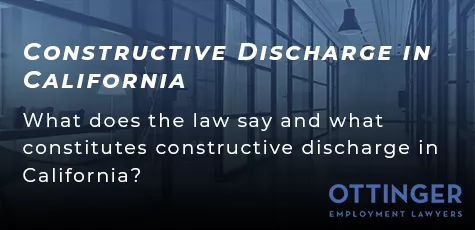What is Constructive Discharge in California

Constructive discharge is a term used to describe a situation where an employer forces an employee to quit.
This is often referred to as constructive dismissal or constructive termination.
Rather than firing an employee for an illegal reason, some California employers attempt to skirt liability by forcing the employee to resign.
A constructive discharge occurs when an employee is coerced into resigning and writing a resignation letter as a result of the employer imposing unusually intolerable working conditions on the employee with the intention of forcing the employee to quit.
In such cases, the employee’s resignation has legally been deemed a firing rather than a voluntary resignation.
The California employment lawyers at Ottinger Employment Law will explain. Call our firm at (800) 668-7984 or contact us online for further assistance.
What is the Best Way to Prove a Constructive Discharge Claim in California?
Establishing a claim of California constructive discharge requires the employee to prove:
“That the employer either intentionally created or knowingly permitted working conditions that were so intolerable or aggravated at the time of the employee’s resignation that a reasonable employer would realize that a reasonable person in the employee’s position would be compelled to resign.” Vasquez v. Franklin Real Estate Fund, Inc.
Employees may not just “quit and sue” based on a charge of constructive discharge or termination.
The facts must show that the employee was coerced or forced into quitting rather than simply making a rational choice to quit.
“The conditions giving rise to the resignation must be sufficiently extraordinary and egregious to overcome the normal motivation of a competent, diligent and reasonable employee to remain on the job to earn a livelihood and to serve his or her employer.” Id.
The standard applied in determining whether or not there has been a constructive discharge in California is an objective one, and it is a question of fact – “whether a reasonable person faced with the allegedly intolerable employer actions or conditions would have no reasonable alternative except to quit.” Id.
California Constructive Discharge Examples
Courts have held that the following types of employer conduct are not, on their own, enough to amount to constructive discharge or dismissal:
- The mere existence of a legal violation in the workplace. Id.
- An isolated instance of employment discrimination. Soules v. Cadam, Inc.
- A poor performance rating accompanied by a demotion and reduction in pay. Vasquez.
- Changing an instructor’s schedule from full-time to part-time. Scotch v. Art Institute of California.
- Reducing an employee’s salary and changing his or her annual bonus. King v. AC & R Advertising.
- When it turns out that the job the employee accepts is more difficult than or otherwise different from what the employee expected. Rochlis v. Walt Disney Co.
- Receiving criticism and being paid less than the employee believes he deserves. Id.
However, courts have held that the following types of employer conduct could amount to constructive discharge in California:
- An employee was subjected to a violation of the California Labor Code (failure to reimburse business expenses) so egregious that it resulted in the employee being paid less than minimum wage, forcing the employee to divert a substantial amount his salary to pay his employers expenses and leaving the employee unable to pay basic living expenses. Vasquez.
- When an employee is subjected to a continuous pattern of discrimination by the employer on the basis of race, sex, age or national origin. Watson v. Nationwide Insurance Co.
- An employee was physically threatened on one occasion, harassed over a period of two weeks, and not given sufficient work instructions to perform his job. Ford v. Alfaro.
- An employee was subjected to three racial insults within a matter of hours and, upon quitting, was told, “You’d stay if you weren’t a sissy. If you were a man, you’d stay.” Watson (citing Bailey v. Binyon).
- An employee who had previously received only excellent performance ratings was subjected to citations for rule violations that other similarly situated employees did not receive, to trumped–up charges of inadequate job performance, and to abusive treatment and harassment, including being told in a four–hour meeting that she was a poor and incompetent supervisor. Watson.
Contact a California Unemployment Lawyer Near Me for Help
If you believe your employee rights have been violated or would like additional information about California constructive discharge lawsuits, please contact us online or call (800) 668-7984 for help.
Our California employment law attorneys are ready to fight for your rights as an employee.


